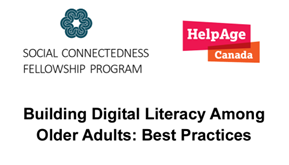[Research Report] Building Digital Literacy Among Older Adults: Best Practices

This research project, in partnership with HelpAge Canada, explored best practices for building digital literacy among older adults. The aim of this research project was to explore and understand the barriers and facilitators experienced by older adults when learning digital literacy skills. Semi-structured, in-depth qualitative interviews were conducted with 10 stakeholders, including program participants and program delivery personnel in the Dig-IT program, researchers in the field of digital literacy, as well as individuals from leading organizations providing digital literacy training to older adults in North America. Findings from the interviews revealed barriers relating to affordability as well as fear and anxiety. The ability to afford a device and internet services were described as “out of reach for many older adults”, and acted as barriers to acquiring digital literacy skills and contributed to the digital divide among this population. Fear and anxiety were prominently discussed as barriers in the literature and during interviews with program delivery personnel and older adult participants. This was attributed to limited prior exposure to information and communication technologies, as well as the ever-evolving nature of technology that requires constant upgrading of skills.
Best practices were discerned in relation to program planning and delivery.
- Marketing of the program: Focus on the goals and interests of the older adult participants to increase uptake and motivation.
- Community-based: Working with community organizations can help to identify eligible older adults and elicit trust. In rural and remote areas, look for areas where people congregate to host the training.
- Accessibility: The tablet was the preferred device among older adults due to the large screen and portability. Providing a stylus can be useful for older adults with dexterity challenges. Translating the curriculum into multiple languages can help to reach diverse groups of older adults.
- Flexibility in program delivery models: Provide a range of delivery methods such as 1:1 training, group-based classes and/or drop-in sessions for troubleshooting.
- Cybersecurity: Ensure participants understand common online scams and how to keep their personal information secure.
- Peer-to-peer teaching: Support older adults in learning from one another by allotting time for discussion throughout the training, and providing opportunities for older adult graduates of the program and advanced users to co-facilitate.
File Attachments
| 1 |
30702_Emily-Final-Report-Building-Digital-Literacy-Among-Older-Adults.pdf
0.34MB
|
|
| 2 |
30706_older_adult_digital_literacy_best_practices.pdf
1.3MB
|
-
By
Emily Mullins, HelpAge Canada
-
Published
Mar 26, 2024
-
Subject Area
- Technology & Digital Literacy
-
Audience
- Service Providers (Non-profits, Community Organizations, Local government)
- Caregivers, Seniors & Volunteers
- Government (Politicians, Policy Makers) and Health Authorities
-
Category
Newsletter
Sign up for the Healthy Aging CORE Alberta e-news to keep up-to-date with activity from the platform and the Community-Based Seniors Services (CBSS) sector across the province.
